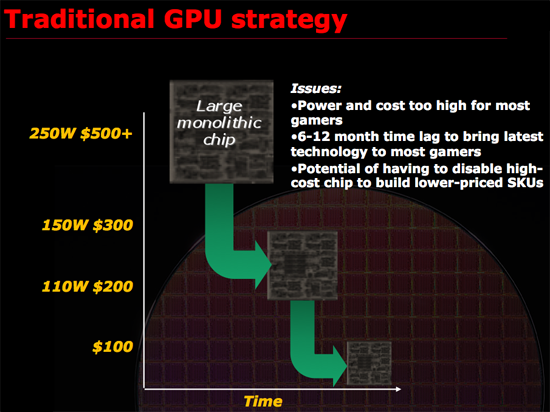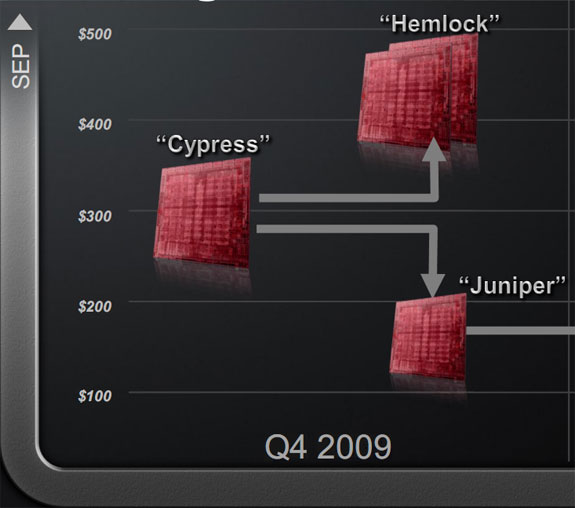The RV870 Story: AMD Showing up to the Fight
by Anand Lal Shimpi on February 14, 2010 12:00 AM EST- Posted in
- GPUs
What Made it All Ok: 4 GPUs in < 6 Months
Through a lot of hard work and sacrifice, even on Carrell’s part, ATI cut the RV870 from as much as 22mm on a side down to roughly 18mm x 18mm. The problem is that RV770 was around 16mm on a side. The RV870 was still too big.
Carrell wanted to cut it down even more, but two things changed his mind. First, in order to build 870 in the space of a 770 ATI would have to cut out much more from the chip than Carrell originally tought. One of the things that would have to go was some of the shader core.
In order to run the GDDR5 memory at the sort of data rates that ATI was targeting for the 5870 the analog PHYs on the chip had to grow considerably. At 16mm on a side ATI would either have to scale back memory bandwidth or eat into the shader core area. Either way we would’ve had a slower chip.
I asked Carrell if 16mm on a side would’ve made the RV870 $100 cheaper at launch, putting it on par with the RV770 launch prices. He said no. I didn’t find out why until much later, but I’ll save that story for another time.
Sacrificing performance to meet the 16mm x 16mm die size targets wasn’t going to happen, but what ultimately convinced Carrell to go with a larger die this time around was something that ATI didn’t get nearly enough praise for: the ability to launch 4 different 40nm DirectX 11 GPUs in less than 6 months.
Remember that Carrell’s beef with building the biggest GPU possible is that it takes too long for the majority of customers to get access to derivatives of that GPU. Look at how long it took G80 or GT200 to scale down. And who knows when we’ll see $150 Fermi/GF100 derivatives.

But ATI Engineering promised two things. First, that Cypress would have a successor called Juniper that would be ready around the same time. Secondly, two more GPUs would follow and the whole stack will be done and out in less than 6 months. ATI came close in 2008 with 3 GPUs in 3 months, but the fourth member of the 4000 series didn’t show up until April of 2009.
It wasn’t an impossible feat. ATI does have concurrent design teams and a lot of engineering resources in India/China. By working on Juniper in tandem with Cypress, assuming there were no show stopping bugs, ATI could exploit efficiencies in two teams effectively working on the same hardware (Juniper was just half a Cypress).
The idea of taking such a huge risk made Carrell uncomfortable. Running two GPU designs in parallel, for the same family of chips, is risky. If everything works out perfectly, you get two chips out at the same time. If it doesn’t, you’ve just tied up two design teams on one product generation. A slip here would give ATI its own Fermi.
What ultimately sold Carrell was the fact that engineering told him that they believed they could pull it off. Carrell believes in people. He believes if you expect the best out of those around you, then that’s what you’ll get. He couldn’t reconcile his beliefs with doubting the schedule engineering was feeding him. Carrell nervously signed off and the Evergreen stack was born.

Cypress and Juniper were delivered nearly at the same time. In fact, Juniper was ready a bit earlier and was sampled to developers months before ATI launched the 5000 series. Cedar and Redwood followed, not to mention a dual-Cypress board that became the Radeon HD 5970. And all of this was done and ready in less than 6 months (the chips themselves were all ready within 4 months).
When the smoke cleared ATI had new DirectX 11 parts at $600, $400, $300, $200, $150, $100 and $60. The Windows 7/DirectX 11 market bulge just got serviced.










132 Comments
View All Comments
AdiQue - Sunday, February 14, 2010 - link
I fully subscribe to point raised by a few previous posters. Namely, the article being such a worthy read, it actually justifies the creation of an account for the sheer reason of expressing appreciation to your fantastic work, which does stand out in the otherwise well saturated market of technology blogs.geok1ng - Sunday, February 14, 2010 - link
"I almost wonder if AMD’s CPU team could learn from the graphics group's execution. I do hope that along with the ATI acquisition came the open mindedness to learn from one another"it would be a true concern if based on mere observation, but the hard facts are soo much terrible: AMD fired tons of ATI personnel, hence ATI drivers are years behind NVIDIA- we are still begging for centered timings on ATO cards, a feature that NVIDIA offers 6 generations past! ATI produces cards that are gameless. DirectX 10.1?! There was a single game with DirectX 10.1 support, and NVIDIA made the game developer REMOVE DirectX 10.1 features with a game patch that "increased" performance. DirectX 11?! ATI has to put money on driver developing team and spend TONS of cash in game developing.
I would be a happier costumer if the raw performance of my 4870X2 was paired with the seamless driver experience of my previous 8800GT.
And another game that AMD was too late is the netbook and ultralow voltage mobile market. A company with the expertise in integrated graphics and HTPCs GPUs with ZERO market share on this segment?! give me a break!
LordanSS - Monday, February 15, 2010 - link
Funny... after the heaps of problems I had with drivers, stability and whatnot with my old 8800GTS (the original one, 320MB), I decided to switch to ATI with a 4870. Don't regret doing that.My only gripe with my current 5870 is the drivers' and the stupid giant mouse cursor. The Catalyst 9.12 hotfix got rid of it, but it came back on the 10.1.... go figure. Other than that, haven't had problems with it and have been getting great performance.
blackbrrd - Monday, February 15, 2010 - link
I think the reason he had issues with the X2 is that it's a dual card. I think most gfx card driver problems comes from dual cards in any configuration (dual, crossfire, sli)The reason you had issues with the 320mb card is that it had some real issues because of the half-memory. The 320mb cards where cards originally intended as gtx cards, but binned as gts cards that again got binned as 320mb cards instead of 640mb cards. Somehow Nvidia didn't test these cards good enough.
RJohnson - Sunday, February 14, 2010 - link
Please get back under your bridge troll...Warren21 - Sunday, February 14, 2010 - link
Are you kidding me? Become informed before you spread FUD like this. I've been able to choose centered timings in my CCC since I've had my 2900 Pro back in fall 2007. Even today on my CrossFire setup you can still use it.As for your DX10.1 statement, thank NVIDIA for that. You must remember that THEY are the 600lb gorilla of the graphics industry - I fail to see how the exact instance you cite does anything other than prove just that.
As for the DX11 statement, if NVIDIA had it today I bet you'd be singing a different tune. The fact that it's here today is because of Microsoft's schedule which both ATI and NVIDIA follow. NV would have liked nothing more than to have Fermi out in 2009, believe that.
Kjella - Sunday, February 14, 2010 - link
"AMD fired tons of ATI personnel, hence ATI drivers are years behind NVIDIA-"Wow, you got it backwards. The old ATI drivers sucked horribly, they may not be great now either but whatever AMD did or didn't do the drivers have been getting better, not worse.
Scali - Sunday, February 14, 2010 - link
It's a shame that AMD doesn't have its driver department firing on all cylinders like the hardware department is.The 5000-series are still plagued with various annoying bugs, such as the video playback issues you discovered, and the 'gray screen' bug under Windows 7.
Then there's OpenCL, which still hasn't made it into a release driver yet (while nVidia has been winning over many developers with Cuda and PhysX in the meantine, while also offering OpenCL support in release drivers, which support a wider set of features than AMD, and better performance).
And through the months that I've had my 5770 I've noticed various rendering glitches aswell, although most of them seem to have been solved with later driver updates.
And that's just the Windows side. Linux and OS X aren't doing all that great either. FreeBSD isn't even supported at all.
hwhacker - Sunday, February 14, 2010 - link
I don't log in and comment very often, but had to for this article.Anand, these type of articles (Rv770,'Rv870',and SSD) are beyond awesome. I hope it continues for Northern Islands and beyond. Everything from the RV870 jar tidbit to the original die spec to the SunSpotting info. It's great that AMD/ATi allows you to report this information, and that you have the journalistic chops to inquire/write about it. Can not provide enough praise. I hope Kendell and his colleagues (like Henri Richard) continue this awesome 'engineering honesty' PR into the future. The more they share, within understandable reason, the more I believe a person can trust a company and therefore support it.
I love the little dropped hints BTW. Was R600 supposed to be 65nm but early TSMC problems cause it revert to 80nm like was rumored? Was Cypress originally planned as ~1920 shaders (2000?) with a 384-bit bus? Would sideport have helped the scaling issues with Hemlock? I don't know these answers, but the fact all of these things were indirectly addressed (without upsetting AMD) is great to see explored, as it affirms my belief I'm not the only one interested in them. It's great to learn the informed why, not just the unsubstantiated what.
If I may preemptively pose an inquiry, please ask whomever at AMD when NI is briefed if TSMC canceling their 32nm node and moving straight to 28nm had anything to do with redesigns of that chip. There are rumors it caused them to rethink what the largest chip should be, and perhaps revert back to what the original Cypress design (as hinted in this article?) for that chip, causing a delay from Q2-Q3 to Q3-Q4, not unlike the 30-45 day window you mention about redesigning Cypress. I wonder if NI was originally meant to be a straight shrink?
hwhacker - Sunday, February 14, 2010 - link
I meant Carrell above. Not quite sure why I wrote Kendell.